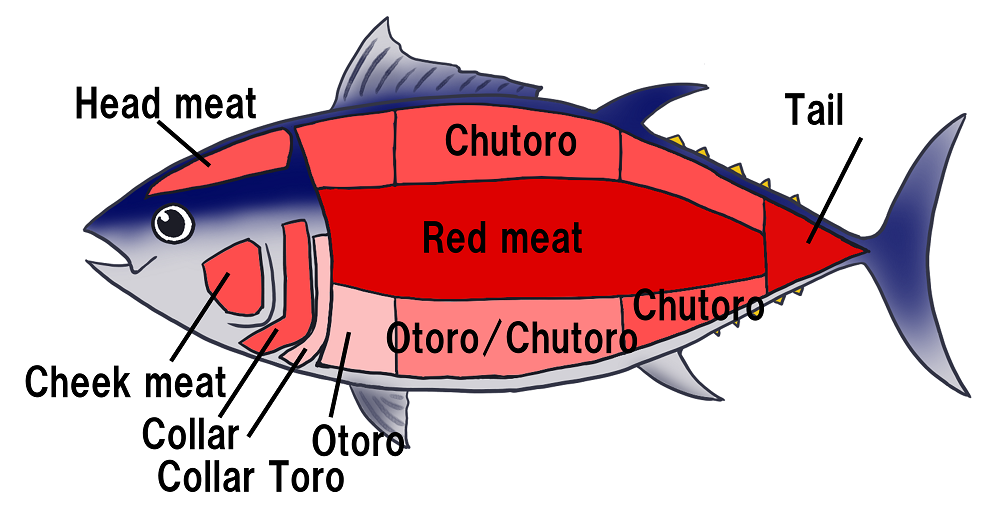Edible Parts and Nutrient
Edible parts of tunas

|
Collar
This is a Red meat
It is found on the inside of the belly and back muscles, surrounding the bone. It is Bloody meatIt is present in almost the same place as red meat, parts close to the spine. Valued for its edible qualities. Toro (fatty meat)You have probably heard of this part of the fish. It is divided into three main sections from the head: top, middle and bottom. The upper part is the most expensive and has the richest flavor, while the lower part is less expensive compared to the head. The bottom is Chutoro, which is less expensive than Otoro. |
Nutrient values of tunas
This section introduces nutrient value of tunas.
Among the effects contained in tuna, the following three nutritional components are noteworthy: proteins, inorganic substances/vitamins, and polyunsaturated fatty acids (DHA/EPA).
Proteins
Proteins are especially
Inorganic substances/vitamins
These include
DHA・EPA
We humans cannot synthesize DHA and EPA in our bodies, so we need to take them in our diet.

|
It was found that tuna contains many nutrients that can prevent diseases, such as increasing the number of good cholesterol in the blood and improving blood and cholesterol metabolism. It seem that the tuna are not only preventing diseases, but also effective in learning and skin care, and so on. |
Tuna Quiz (3)
Which of the nutrients contained in tuna is said to be effective in improving learning ability?
Proteins
Incorrect!Protein is a nutrient that builds our bodies.
DNA
Incorrect!DNA (deoxyribonucleic acid) is the substance that consisting of genes.
DHA
Correct!DHA is a kind of nutrient called polyunsaturated fatty acid, and EPA is well known.
Reference
![]() とれたてねっと>鮪 コラム一覧>マグロに含まれている栄養成分とは?どんな効果効能が期待できる?
とれたてねっと>鮪 コラム一覧>マグロに含まれている栄養成分とは?どんな効果効能が期待できる?
(translated title: Tuna Column>What are the nutrients contained in tuna? What kind of beneficial effects can be expected?)
https://toretate-gift.com/user_data/column/maguro/02/
(Confirmed:2023/1/7)
(in Japanese)
![]() マグロのふしぎがわかる本 (translated title: A book that understands the mystery of tuna)
マグロのふしぎがわかる本 (translated title: A book that understands the mystery of tuna)
Publisher:TSUKIJI SHOKAN PUBLISHING
Authors:Hideki Nakano and Masakazu Oka
(in Japanese)
![]() Home
© 2022-2023 マグロの学校/School-of-Tuna All rights reserved.
Home
© 2022-2023 マグロの学校/School-of-Tuna All rights reserved.